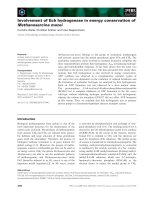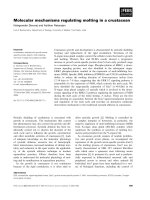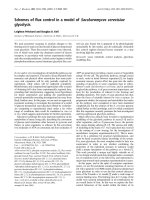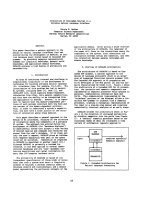Báo cáo khoa học: "Giant secreting adrenal myelolipoma in a man: a case report" pptx
Bạn đang xem bản rút gọn của tài liệu. Xem và tải ngay bản đầy đủ của tài liệu tại đây (634.41 KB, 4 trang )
CAS E REP O R T Open Access
Giant secreting adrenal myelolipoma in a man:
a case report
Alfio Brogna, Giuseppe Scalisi
*
, Rosario Ferrara and Anna M Bucceri
Abstract
Introduction: Adrenal myelolipoma is a rare, benign neoplasm that is usually asymptomatic, unilateral and
nonsecreting. It develops within the adrenal gland and is composed of mature adipose tissue with elements of the
hematopoietic series. We describe the case of what is, to the best of our knowledge, one of the largest secreting
adrenal myelolipomas reported in the literature.
Case presentation: A 52-year-old Caucasian man of medium build who had had moderate hypertension for three
years presented to our hospital. He had no other significant symptoms. His hypertension was pharmacologically
treated. He came to our hospital to undergo abdominal ultrasonography during a clinical checkup. The ultrasound
scan showed the presence of a voluminous hyperechoic mass interposed between the spleen and the left kidney.
It was reported as a myelolipoma of the left kidney on the basis of its structural characteristics and position.
Computed tomography confirmed our diagnosis. All preoperative biochemical tests were normal, with the
exception of high serum cortisol, which was being overproduced by the lesion and was probably responsibl e for
the patient’s hypertension. He underwent successful surgery, and his postoperative course was uneventful. Th e
pathologic examination of the lesion confirmed the diagnosis of adrenal myelolipoma. The patient ’s blood pressure
returned to within the normal range.
Conclusions: The “incidental” discov ery of an adrenal mass requires careful diagnostic study to plan adequate
therapeutic management. Both of the primary investigations at our disposal, ultrasound and blood tests (adrenal
hormones), helped in rendering the diagnosis and allowed us to move toward the most appropriate treatment,
taking into account the size of the tumor and its probable hormonal production.
Introduction
The myelolipoma is a rare, benign n eoplasm composed
of mature adipocytes and hematopoietic tissue. It was
first described by Gierke in 1905 and subsequently by
Oberling in 1929, who used the term “myelolipoma” [1].
In the past, the finding of adrenal lesions was made pos-
sible by autopsy or by clinical presentat ion, related either
to the massive growth of the gland or to altered hormone
production. Today these tumors can be discovered inci-
dentallybecauseofthewideuseofdiagnosticimaging
methods, such as ultrasonography (US), computed tomo-
graphy (CT) and magnetic r esonance imaging [2].
Although the incidence of these tumors is unknown, it is
thought to be between 0.08% and 0.4%. Men and women
seem to be equally affected by these tumors. Adrenal
myelolipoma is most commonly found between the fifth
and seventh decades of life [3]. In the latter age group, its
low incidence seems to have increased by 0.2% to 10%
since the mid-1990s [4].
These lesions are usually unilateral and asymptomatic. A
certain number of bilateral tumors have been described in
the literature. Myelolipomas are often smaller than 4 cm
in diameter, although they can reach wider sizes [5]. The
largest adrenal myelolipoma reported in the literature
weighed 6 kg and measured 31 cm × 24.5 cm × 11.5 cm
[6,7]. After surgical excision, these lesions generally do not
recur. They are generally nonsecreting, although an over-
production of adrenal hormones is described in some
cases. More than 25 cases of endocrine dysfunction asso-
ciated with myelolipoma have been reported in the Eng-
lish- and Japanese-language literature [5,8,9]. Here we
describe one of the largest cortisol-secreting myelolipomas
ever reported in the literature [10,11].
* Correspondence:
Department of Internal Medicine, Gastroenterology Unit, S. Luigi Hospital,
Viale Fleming 24, I-95100 Catania, Italy
Brogna et al. Journal of Medical Case Reports 2011, 5:298
/>JOURNAL OF MEDICAL
CASE REPORTS
© 2011 Brogna et al; licensee BioMed Central Ltd. This is an Open Access article distributed u nder the terms of the Creative Commons
Attribution License ( which permits unrestricted use, distribution, and reproduction in
any medium, provided the original work is prope rly cited.
Case presentation
We report the case of a 52-year-old Caucasian man of
medium build who had had moderate hypertension for
three years. He referred to no other noticeable symptom.
His hypertension was pharmacologically treated. The
patient came to our hospital to undergo abdominal ultra-
sonography during a clinical checkup. US showed the
presence of a large hyperechoic mass (Figure 1) with
non-well-defined boundaries that made it difficult to
measure its exact size. It seemed to be 20 cm in diameter.
The mass was interposed between the spleen and the left
kidney. The left kidney was displaced downward. A prob-
able myelolipoma of the left adrenal gland was diagnosed.
Contrast-enhanced CT was proposed to confirm the
diagnosis. The abdominal CT scan confirmed the pre-
sence of an expansive lesion (Figure 2) largely occupying
the left hemiabdomen. Such a lesion rising from the left
adrenal gland had frankly fat content, with delta numbers
equal to a mean of -130 HU. It had sharp, regular bound-
aries with starl ike central calcifications. It was suggestive
of a giant left adrenal myelolipoma. The spleen was
pushed against the costal wall and slightly displaced cra-
nially, while the left kidney was pushed downward and
the left renal artery and vein were stretched. The com-
pression exerted on the vein caused a dramatic ipsilateral
spermatic varicocele. The pancreatic gland at the tail, the
splenic artery and vein as well as the left colonic flexure
were displaced anteriorly. Preoperatively, his routine
biochemistry was normal (hemochrome with formula,
liver and kidney function), while his serum cortisol level
was increased (cortisol at 10 a.m. = 743 nmol/L, cortisol
at 2 p.m. = 637 nmol/L, cortisol at 6 p.m. = 649 nmol/L;
ranges, 7 a.m. to 10 a.m., 171 to 536 nmol/L; 4 to 8 p.m.,
64 to 327 nmol/L). His glucose level was 122 mg/dL
(range, 60 to 110 mg/dL). His urinary catecholamines
were normal.
A surgical left adrenalectomy was performed. The
surgically removed myelolipoma showed it to have an
oval shape (about 25 cm × 20 cm × 20 cm), and it
weighed 4.4 kg. Sectioning revealed areas representing
well-differentiated fat. The histologi cal examination
revealed the presence of a dipose tissue with hemato-
poietic elements without signs of cellular atypia, thus
confirming the initial diagnosis. The patient’ spost-
operative course was altogether uneventful.
Discussion
Adrenal myelolipoma is often an “incidentaloma,” since its
diagnosis is frequently based on autopsic findings or upon
diagnostic imaging examinations performed for reasons
unrelated to its presence. These tumors are rare, although
they are increasingly being detected because of wider use
of diagnostic imaging techniques. They are benign and
nonfunctional tumors composed of mature adipocytes and
active hematopoietic elements. Their histogenesis is uncer-
tain. According to some authors, the tumor develops from
Figure 1 US scan of the abdomen showing a myelolipoma. A homogeneous hyperechoic mass in the upper abdomen that displaces the
left kidney downward is shown.
Brogna et al. Journal of Medical Case Reports 2011, 5:298
/>Page 2 of 4
residual embryonic cells of the bone marrow that, after
embolization, reach the adrenal gland. According to a
recent theory, myelolipoma originates from a metaplastic
process of the reticuloendothelial cells within adrenal
capillaries. Some authors even consider the development
of adrenal myelolipomas as a response to various endo-
crine stimulations [2]. This hypothesis is confirmed by the
autopsic findings of myelolipomas in patients who died as
a result of chronic systemic diseases. Other contemporary
authors have speculated about a stressful lifestyle and an
unbalanced diet as factors that may be involved in the
pathogenesis of this tumor [4]. An increase in mass is very
slow, becoming symptomatic only when, because of an
increase in the volume of tumor compression, phenomena
are diagnosed and/or the tumor spreads to neighboring
organs. Hemorrhage or necrosis that occur within the
tumor can cause pain. Hypertension and hematuria may
be other symptoms reported by the patient, who usually
has a strong constitution or may be obese [2]. Myelolipo-
mas associated with Cushing’s syndrome, Conn syndrome
and congenital adrenal hyperplasia caused by a deficiency
of 21-a hydroxylase or 17-a hydroxylase [3,10] have been
described. An unusual and unexplained observation is the
predominance of the tumor borne by the right adrenal
gland [4]. The differential diagno sis should incl ude renal
angiomyolipoma, retroperitoneal lipoma and liposarcoma
[12].
In the clinical case we have described here, it is interest-
ing to note the hyperincretion of cortisol by the myeloli-
poma. This hyperincretion was probably responsible for
the patient’s hypertension, since his blood pressure was
normalized after surgical removal of the tumor and there-
after his blood pressure remained within normal values.
Another rare feature to consider is the left-sided posi-
tion of the myelolipoma in our patient, because they
have been report ed in the literatur e to be prevalent
mostly on the right side. This location has probably
facilitated the rise of a left spermatic varicocele even if
the patient is asymptomatic.
Conclusions
The “incidental” discovery of an adrenal mass requires
careful diagnostic study to plan an appropriate treat-
ment. Imaging techniques at our disposal today can help
the clinician to render the diagnosis. Since myelolipo-
mas consist mainly of adipose tissue, their sharp hypere-
chogenicity observed on US may orient the clinician
toward the diagnosis, but US does not yield any certain
detail about natur e of lipomatous lesions. CT can clarify
the nature of incidentalomas, as in our patient, and can
indicate the best treatment, taking into consideration
the tumor size and its possible hormone production.
Biochemical studies are also useful and necessary in the
typing of the mass.
Figure 2 Myelolipom a identified by CT. Contrast-enhanced CT scan of the upper abdomen shows a large heterogeneous mass covering the
upper left retroperitoneal space.
Brogna et al. Journal of Medical Case Reports 2011, 5:298
/>Page 3 of 4
Consent
Written informed consent was obtained from the patient
for publication of this case report and any accompany-
ing images. A copy of the written consent is available
for review by the Editor-in-Chief of this journal.
Abbreviations
CT: computed tomography; MRI: magnetic resonance imaging; US:
ultrasonography.
Authors’ contributions
AMB and GS collected the data and drafted the manuscript. AB and RF took
care of the patient during his hospitalization. All authors read and approved
the final manuscript.
Competing interests
The authors declare that they have no competing interests.
Received: 22 July 2010 Accepted: 9 July 2011 Published: 9 July 2011
References
1. Ersoy E, Ozdoğan M, Demirağ A, Aktimur R, Kulaço ğlu H, Kulaçoğlu S,
Gündoğdu H: Giant adrenal myelolipoma associated with small bowel
leiomyosarcoma: a case report. Turk J Gastroenterol 2006, 17:126-129.
2. Cristofaro MG, Lazzaro F, Fava MG, Aversa C, Musella M: Giant adrenal
myelolipoma: a case report and review of the literature in Italian. Ann
Ital Chir 2004, 75:677-681.
3. Doddi S, Singhal T, Leake T, Sinha P: Management of an incidentally
found large adrenal myelolipoma: a case report. Cases J 2009, 2:8414.
4. Tyritzis SI, Adamakis I, Migdalis V, Vlachodimitropoulos D, Constantinides CA:
Giant adrenal myelolipoma, a rare urological issue with increasing
incidence: a case report. Cases J 2009, 2:8863.
5. Daneshmand S, Quek ML: Adrenal myelolipoma: diagnosis and
management. Urol J 2006, 3:71-74.
6. Mukherjee S, Pericleous S, Hutchins RR, Freedman PS: Asymptomatic giant
adrenal myelolipoma. Urol J 2010, 7:66-68.
7. Akamatsu H, Koseki M, Nakaba H, Sunada S, Ito A, Teramoto S, Miyata M:
Giant adrenal myelolipoma: report of a case. Surg Today 2004, 34:283-285.
8. Boudreaux D, Waisman J, Skinner DG, Low R: Giant adrenal myelolipoma
and testicular interstitial cell tumor in a man with congenital 21-
hydroxylase deficiency. Am J Surg Pathol 1979, 3:109-123.
9. Allison KH, Mann GN, Norwood TH, Rubin BP: An unusual case of multiple
giant myelolipomas: clinical and pathogenetic implications. Endocr Pathol
2003, 14:93-100.
10. Hagiwara H, Usui T, Kimura T, Tagami T, Naruse M, Minamiguchi S, Kato T,
Okuno H, Shimatsu A: Lack of ACTH and androgen receptor expression in
a giant adrenal myelolipoma associated with 21-hydroxylase deficiency.
Endocr Pathol 2008, 19:122-127.
11. Lamas C, López LM, Lozano E, Atienzar M, Ruiz-Mondéjar R, Alfaro JJ,
Botella F: Myelolipomatous adrenal masses causing Cushing’s syndrome.
Exp Clin Endocrinol Diabetes 2009, 117:440-445.
12. Répássy DL, Csata S, G Sterlik G, Iványi A: Giant adrenal myelolipoma.
Pathol Oncol Res 2001, 7:72-73.
doi:10.1186/1752-1947-5-298
Cite this article as: Brogna et al.: Giant secreting adrenal myelolipoma
in a man: a case report. Journal of Medical Case Reports 2011 5:298.
Submit your next manuscript to BioMed Central
and take full advantage of:
• Convenient online submission
• Thorough peer review
• No space constraints or color figure charges
• Immediate publication on acceptance
• Inclusion in PubMed, CAS, Scopus and Google Scholar
• Research which is freely available for redistribution
Submit your manuscript at
www.biomedcentral.com/submit
Brogna et al. Journal of Medical Case Reports 2011, 5:298
/>Page 4 of 4









